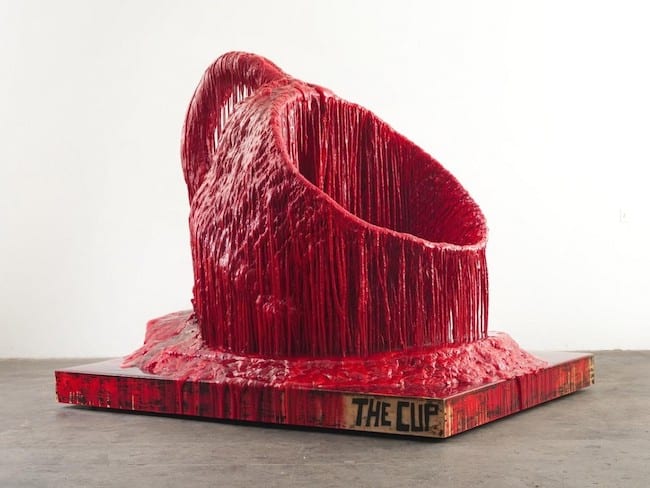In his recent exhibition (9 May – 25 July 2014) Sunrise Sunset, at Hauser + Wirth, New York by Los Angles artist Sterling Ruby has little in ceramics itself (one piece) but he has much to say about the medium from the show’s tours de force, Cup to the giant bronze Debt Basins which strike me as a homage to Peter Voulkos, an admitted influence on his art. — Garth Clark
Below is the gallery’s description of the exhibition:
Possessed of a profound material sensibility, Sterling Ruby’s art speaks in a language inspired by sub-cultural phenomena ranging from graffiti, urban gangs, and prison systems, to craft and the history of quilt-making. Ruby’s work, which encompasses nearly every medium, voraciously cycles through the autobiographical, the art historical, and the sociological, creating layers of reciprocal influence that radiate outward. Ruby exploits tensions within aesthetic and societal systems, recreating and drawing our attention to repressive and liberated states.
The massive blood-red urethane sculpture, Cup (2013), tilted at an angle, is caught in the moment between pouring and containing the flowing rivulets of polymer compound that monumentalize the artist’s temporal gestures. The sculpture captures the expressive act of a fleeting moment and embodies a process-driven practice that privileges gesture and expression.

Sterling Ruby, Pillars, 2014, PVC pipe, foam and urethane, Pillar 1: 327.7 x 123.2 x 124.5 cm / 129 x 48 1/2 x 49 in, Pillar 2: 337.8 x 125.7 x 121.9 cm / 133 x 49 1/2 x 48 in, Pillar 3: 341.6 x 121.9 x 121.9 cm / 134 1/2 x 48 x 48 in, Pillar 4: 340.4 x 123.2 x 121.9 cm / 134 x 48 1/2 x 48 in
Also on view is a set of poured urethane Pillars. Reminiscent of the artist’s stalagmite sculptures, these are large freestanding columns that transform his dripping geologic forms into architectural columns, a shift from prehistoric to historic time.

Sterling Ruby, BASIN THEOLOGY_2C-T-XX, 2013, ceramic 61 x 132.7 x 111.1 cm, 24 x 52 1/4 x 43 3/4 in
The artist’s Basin Theology series consists of large vessels filled with fragments from broken and mis-fired pieces collected from previous ceramic works. Brilliantly glazed in bright yellow, green and red Basin Theology/2C-T-XX (2013) is named for a synthetic hallucinogenic drug with effects similar to mescaline and MDMA.

Sterling Ruby Debt Basin Vertical 2, 2014, bronze with stainless steel armature 260.4 x 247.7 x 108 cm, 102 1/2 x 97 1/2 x 42 1/2 in
The oversized Debt Basins (2014) are cast in bronze from clay molds. Pouring metal in smaller sections that are then joined together, Ruby reveals the connecting welds in the final sculptures, scarred reminders of the object’s making. Like the ceramic works these basins act as archaeological sites filled with found and broken artifacts, but here they are upended and mounted to the wall, shifting the horizontal to the vertical.
Featured image: Sterling Ruby, The Cup, 2013, foam, urethane, wood and spray paint, 233.7 x 293.4 x 223.5 cm, 92 x 115 1/2 x 88 in. All photographs courtesy of the gallery.
Any thoughts about this post? Share yours in the comment box below.

Stering Ruby, Debt Basin Vertical 3, 2014, bronze with stainless steel armature 247.7 x 248.9 x 124.5 cm, 97 1/2 x 98 x 49 in


Installation views of Sterling Ruby’s “SUNRISE SUNSET” exhibition at Hauser & Wirth, New York.

all this work comes off as gestural, dancing around the figural. (what IS it? it’s poured. no, it’s a cup. no, it’s drooping. wait, it’s a vessel….) so there’s an interesting tension, between being and doing. but that tension depends just as much on the medium as the message, and that’s where his choices warrant scrutiny. why marry urethane with a giant cup AND a stand of pillars? (in the same exact color?) why use clay AND bronze to contain artefactual remnants? why isn’t big yellow mama made with cardboard or bronze or dripping with urethane? why isn’t hanging figures made with oozing urethane? how come the cup isn’t stuffed fabric? the trough ceramic? sometimes the connecting tensions (between material and object, between substance and thing) work, sometimes they don’t — or, rather, they don’t work in the same way. but maybe that randomness is part of the overarching gesturing? in which case: OK, WHATEVER.